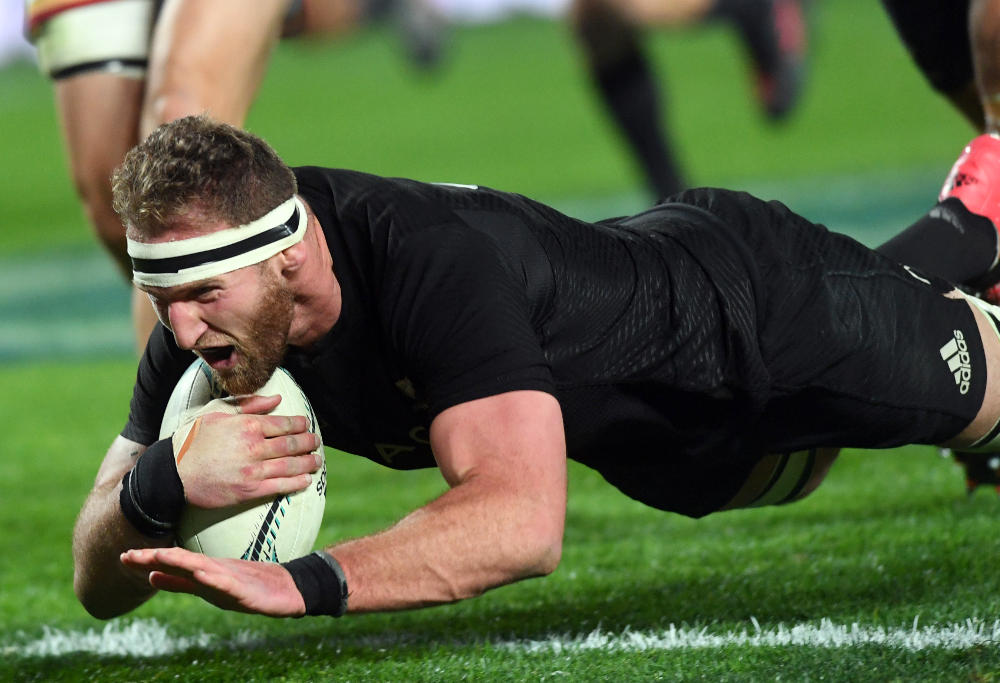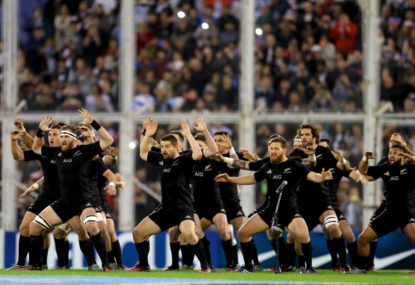The rugby world is chasing the All Blacks.
We non-Kiwis have two basic choices. Model ourselves around the New Zealand model, but do what they do a bit better than them.
Or – as I’ve advocated and may continue to unless someone convinces me otherwise – we can try to be different at rugby, with different parts, perhaps achieve marginal advantages in power and pace, or a shape that is alarming and disturbing to Kiwi senses, and do that so well that we defeat the world’s No.1, and force them to chase us.
Both of these approaches sound like hard work. Inside those two big ideas (copy-but-perfect versus different-and-better) there are hundreds of minute tactical choices of course. But let’s look at the first option, first.
If we are going to out-Kiwi the Kiwis, we first have to understand the model we will adopt. For today, let’s leave aside structural issues and governance.
Not every country is tranquil and comprised of two slender islands flanked by hundreds of other islands, with young athletes drawn like magnets to a handful of safe and prosperous cities, leaders who seldom steal, bound by a love of the oval ball and the passing of it in multiple ways, and the easy willingness to work together for the common good on a wide array of topics. Nor will I discuss the provenance of the array of coaching excellence New Zealand Rugby Union is blessed to enjoy.
Today, I will only discuss the complexion of the All Black team, and then look at what the top tier teams need to do to have the tools to be just like that team, but better.
When we look at their hard-working props with square and massive heads, mobile for big men, who work as hard around the paddock as Oupa Mohoje or Dean Mumm, we seek a few clear mandates: experience, weight, and an ability to play channels on attack and defence where Marcos Ayerza, Jannie du Plessis or Dan Coles would look clumsy and immediately be targeted.
Take the big, soaring, boring Wyatt Crockett. He scrums exotically. But he is experienced. And that matters. If you think you will put your shoulder or thumb in a unique spot, or if you believe your Pilates instructor has found a rare move to throw Wyatt off, forget about it. Seen it. Done it. Crockett was playing in all black jerseys when he was 18, when he was 20, and now.
Owen Franks is more powerful than Crockett, courtesy of a love of strength training. He rarely misses a Test (only 12 matches in seven seasons) and like Crockett, he won national junior honours when he was a teenager. He does not shirk defensive duties – he’s a highlight tackling machine. When things get niggly, Franks looks very happy.
So, we learn from this – if we are only becoming better All Blacks than the All Blacks – that selecting props primarily for their scrum skills is not part of the model. Don’t be a pushover, but more importantly, work around the field, pass and tackle and clean and produce in general play. Charlie Faumuina and Ofa Tu’ungafasi bring plenty of ballast, but even more speed and hunt the big hit or hit up, too.
Australia veers too far from the model by just trying to survive scrums. South Africa has employed too many scrum-centric props, in a century when the scrum has never been less important when compared to ball retention and speed at ruck and the ability to realign on defence or on attack with the minimum of player shifting. Argentina’s powerful props try to emulate New Zealand’s in general play, but are not as sure-handed. England is English; props are phone booths. Movement optional. Samson Lee looks like he would tire after a five-metre gallop. And so on.
And what of the hookers?
Forget battleship Bismarck du Plessis or belligerent Dylan Hartley as a model. Try the nine-test-try Dane Coles and his even smaller understudy Codie Taylor. They’re strong enough to not embarrass themselves in the scrum, but it’s their mobility and speed and ability to break through tackles and flat foot defenders that sets them apart. Taylor’s great-great-grandfather was an All Black, but I don’t think we have to emulate that, nor the fact that Taylor grew up in Australia and was a league player.
Who has a Coles-Taylor duo? For the Boks, that would be Malcolm Marx and Schalk Brits. Gus Creevy can play the Coles game at times, and outplayed him in 2016. Wales has one, France used to, and Australia really does not, squeaking by with blunt instruments.
In the second row, most teams try to distinguish between an enforcer and a lineout maestro, with both supposed to also carry and smash and clean. The All Blacks have Brodie Retallick as a forward-playmaker who passes more than most other teams’ No.8s. Spotted early and developed in a Junior World Championship squad, Retallick has All Black bloodlines (an uncle was a prop for the national team).
Sam Whitelock has the same dimensions as other agile aerial locks: over two metres tall and about 115 kgs. He’s rangy, even more mobile than his mate, and a master thief in the lineout. At age eighteen, he had to choose between basketball and rugby.
The rest of the rugby world already tries to copy the All Blacks second row. England has George Kruis and Maro Itoje, or Joe Launchberry and Courtenay Lawes; the grafters and the basketball players. South Africa has the multi-skilled Stormer duo with plenty of backups. In form, Alun Wyn Jones can play with Whitelock. If Argentina’s Levanini would clean up his act, he fits the mould.
In the loose forwards, the most difficult All Black to emulate is Jerome Kaino. He’s too strong to handle for most opponents, tackles like his life depends on it, and has the slick ball handling skills of a back. Durable and calm and seldom flustered, the last time the Boks had an equal was in Juan Smith’s prime. Since then, it’s been too slow and big or too light or too imprecise. England doesn’t have a Kaino. Chris Robshaw is a good guy, it seems, but he’s no Kaino. The Irish have no Kainos. Nobody does; Scott Fardy and Mumm aren’t in the same postal code.

World rugby has a lot of good No.8s right now. Italy, Wales, France, South Africa, and Argentina can claim some greatness, even if a bit young in some cases. But everyone would love to have Kieran Read, who can dominate games with sleight of hand, or old-fashioned force in the tackle. He was a national cricketer in age-group; perhaps that’s where his eye-hand-ball skills developed.
At openside, the All Blacks just keep churning out a certain model. About 105-108 kg and big enough to win the shoulder battle at the breakdown. Nobody except maybe the Fijians has a hope of fielding an Ardie Savea, but Shag Hansen thinks him too light in the tight-loose. So, it’s Sam Cane or Matt Todd for now. Cane was great at every level, and would have dozens more caps by now, but for a certain man named Richie. Todd looks like he is like-for-like, with Savea a horse for a specific course, only.
Sam Warburton can fit the bill, as can Francois Louw or the currently injured Marcell Coetzee, because all are big enough and comfortable with the full set of duties imposed on an All Black opensider. Sean O’Brien could fit. Argentina seems to be morphing a bit into the All Black mode due to more regular match-ups. I will avoid Pooper talk.
And now we run into a train crash. Halfback. We all want an Aaron Smith. We’d scour the WCs and bug the train station restroom or open every toilet, but we simply can’t find him. And then he was gone and here comes a bigger livewire halfback TJ Perenara with a powerful pass and better scavenging. And if Perenara falls in love with the bathroom attendants in Chicago, there’s bruising Tawera Kerr-Barlow, a serious nuisance in the best sense. It’s a common theme among the All Blacks, but his mum was good enough to play rugby for Australia and his uncle was a national level league player.
So, how do you find someone to pass as crisply as this trio? You don’t. At his best, Conor Murray for Ireland is almost there. England has a couple of nuisances. Greg Laidlaw, who is Brett McKay’s doppelganger, can kick better than TJP or TKB or Smith, but that’s all. South Africa would adopt a quota for Maori if they could get one of the three to change sides.
And it gets worse. Beauden Bok Beating Bastard Barrett can’t kick for poles unless he’s in a hurricane, but he took his bench backline-busting to the starting position and in decidedly mercurial fashion, he can literally change a game in a moment. I think five of his family has played top level rugby in New Zealand, too.
Goalkicking just isn’t the critical factor for a first five-eighth in New Zealand. Aaron Cruden sparks his backline, but he has a knuckleball kick from the tee. It’s all about vision for him.
That’s the thing. They see things nobody else sees. Quade Cooper thinks he sees those things. Jonny Sexton doesn’t have their good passing. Owen Farrell can kick both of them into oblivion, as can Nicolas Sanchez when he’s not diving into the referees’ bad books. Maybe only Handre Pollard showed the ability to make havoc the way Kiwi playmakers do; the long pass or the quick kick. But he is ailing.
Surely we can all find a Ryan Crotty? Once again, he has an athletic mum (water polo for New Zealand) and a first class rugby playing dad, but he doesn’t seem to have superlative speed or skills. He runs great lines. He is brave. Surely South Africa can match him with Rohan Janse van Rensburg or Jan Serfontein, even if Damian de Allende never comes right?
The Welsh hammer is growing old, Bernard Foley is not really the same as Crotty, the English midfielders are steppers instead of ruck target-setters, and Argentina looks like they can match him. The Wallabies do have a couple of midfielders who seem up to Crotty’s standards.
Anto Lienert-Brown is frustrating. He is a kid. He already looks better than Conrad Smith if he stays healthy. I don’t see anyone coming up in any top tier team who looks better.
In short, the midfield is where teams should be able to match New Zealand, but health is a problem, and forming a combination that sticks is also a challenge.
In the back three, you have Israel Dagg, the perfect rugby player, who’s been great since he was a boy, and was a top cricketer; the affable Ben Smith, who makes defences look silly, and could only be emulated perhaps by Willie le Roux if le Roux was consistent and smarter and a lot better; and then big brute force wings like Julian Savea, fifth on the all-time All Blacks Test try-scorers list.
Wales has big wings, but one of them can’t turn and the other can’t catch. England and Australia choose guile over sheer speed. The Boks have old wings, and maybe a real gem in Ruan Combrinck, but as the quota creeps up year by year, he is likely to be replaced. Lambie has the cricket-soccer-rugby skills of Dagg, but not the physical abilities. The Irish can compete, as well as any, with their GAA background.
All in all, even if you were to start copying the All Blacks now, you’d find it very difficult and they seem to have an unlimited like-for-like supply of replacements.
In my next installment, I will write about the “be different” approach.






























































































